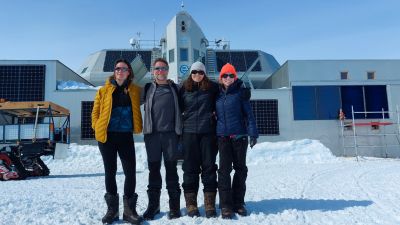
PEA Welcomes First Scientists of the 2021-2022 BELARE Season
The first teams of scientist arrived at Perseus Airstrip last Thursday after a transcontinental flight from Cape Town, South Africa to Antarctica, and they’re already preparing for their first field campaigns.
It already feels a lot more active at the station now that eight scientists from three research projects have arrived. As the Perseus Airstrip eliminates the need to charter a second connector flight once scientists arrive in Antarctica, the team from PEA that drove to the airstrip to groom it nearly two weeks in advance of the plane’s landing brought the scientists and their equipment back to PEA in modified Toyota Hiluxes equipped with caterpillar tracks.
Into the field!
Following two days of mandatory safety training in which all scientists learn (or review for those who are returning to PEA) the basics of surviving in Antarctica: how to handle emergency situations they may encounter, how to use a skidoo, how to use a GPS in the field, and how to extract someone from a crevasse), the scientists started preparing the equipment for their respective field expeditions.
MASS2ANT
A team from the Université Libre de Bruxelles (ULB) led by glaciologist Dr. Frank Pattyn will leave at the end of this week for a three-week stay at the Princess Ragnhild Coast nearly 200 km from PEA to revisit the ice rises their team sampled a few seasons ago as part of the BELSPO-funded MASS2ANT project. As you might recall, during the 2018-2019 reach season, the MASS2ANT team extracted a record 260-metre ice core from that ice rise at coast. The project seeks to better understand the surface mass balance in the region (how much new ice is added to the surface of the ice sheet though precipitation versus how much is lost to calving and ablation).
While they’ll revisit the 260-metre borehole this season to take some extra measurements around it, the MASS2ANT team will only take short ice cores a few meters deep every 50km towards the coast, along with snow samples every 2.5km from the PEA Station to their field camp at the coast. The team will also take ground penetrating radar (GPR) measurements across the whole ice rise, extract a 15 metre-deep shallow core at the corner of the grid. They'll document near surface firn measurements (top 1 metre) at several locations around the ice rise (including radar tracks) and take Polarimetric pRES measurements. This year they’re going to use the shallow ice cores they drill to learn more about snow accumulation over the past few years, and how it varies over the ~200 km transect.
CLIMB
Since their arrival at the station, Preben Van Overmeiren from Ghent University and his colleague Andy Delcloo from the Royal Meteorological Institute of Belgium (KMI / IRM) have been installing and maintaining instruments installed on the roof of the station and the two scientific shelters located nearby on Utsteinen Ridge. Working on the BELSPO-financed CLIMB project their data allow to study many parameters of the atmosphere state and composition.
On Wednesday, Preben already had the opportunity to make day trips to the Antarctic Plateau to perform maintenance and collect the first samples from an active volatile organic compound sampler installed last year and powered by solar panels and a wind turbine. Later on this week, Preben and Andy will join the MASS2ANT team as they head to the coast for their field work. The CLIMB project transect lies along the same transect in which the MASS2ANT team will take samples as they head to the coast.
PEACE
Rounding out the new group of scientists are Simon Steffen (the late Prof. Koni Steffen’s son) and Derek Houtz from the Swiss Federal Institute for Forest, Snow and Landscape Research (WSL) who are working in partnership with the IPF and the University of Colorado Boulder on the Princess Elisabeth Antarctica Climate Experiment (PEACE) project. The project focuses on the collection of meteorological data (wind speed, wind direction, temperature, relative humidity etc. at different level from the ground) along a south-north transect, from the Antarctic Plateau to the lower slope of the ice shelf near the coast.
The ACME project led by the Royal Meteorological Institute of Belgium (KMI / IRM), which is collecting atmospheric data using radio sounding weather balloons, is contributing to the PEACE project, along with the data collected by Automated Weather Station (AWS) in the vicinity of the station.
DOME FUJI
Besides these scientific projects, Expedition Leader Alain Hubert is preparing for a trip to Dome Fuji on the Antarctic Plateau in the framework of a longstanding collaboration between IPF and the Japanese Nataional Insitute for Polar Resaerch (NIPR). This traverse will use tractors from PEA to make the traverse to Dome Fuji, which sits at an altitude of 3800 metres, 880 km from PEA.
Four loaded sledges of fuel had been already been transported 130 km from PEA along the rute during the 2019-20 season in preparation for this traverse. The objective of the mission is to carry out 200 drums of fuel for the future deep ice core drilling mission the NIPR is planning in the coming years. On the return journey to PEA, the team will carry out a number of scientific measurements.
Now inhabited by 40 people, the station will feel a bit less occupied once the scientists head out into the field.
Picture: Scientists from the MASS2ANT project posing in front of the Princess Elisabeth Antarctica - © International Polar Foundation
